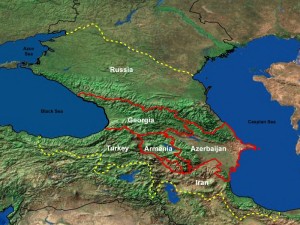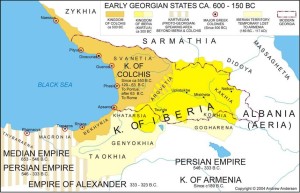Iberia
Darwin, Charles
Charles Darwin (1809-1882) is reported in Wikipedia (a) to have been “dismissive of the ideas that others had put forward of sunken continents like Atlantis.” This opinion is dated to around 1855.
Edward Forbes was one of the first, in 1846 [1471], to hypothesise the existence of a continent in the Atlantic linking Ireland, the Azores and the Iberian Peninsula, which was popularly called ‘Atlantis’. Charles Darwin described his idea as ‘speculative’.
This would appear to conflict with Marco Ciardi, who claimed that Darwin had accepted the existence of Atlantis, I presume later, but did so “under the influence of, among others, the botanist J. D. Hooker” and “reverted to the hypothesis of a lost continent to which the Atlantic islands testified since they constituted the tips of its highest mountains.” This information was cited by Pierre Vidal-Naquet in The Atlantis Story [580.xxii].
Ignatius Donnelly sent a copy of his Atlantis to Darwin, but received a less than enthusiastic response(b).
(a) https://en.wikipedia.org/wiki/Development_of_Darwin%27s_theory
(b) https://www.jasoncolavito.com/blog/friday-odds-and-ends-on-aliens-atlantis-and-more
Caucasus Mountains
The Caucasus Mountains lie between the Black and Caspian Seas and contain the highest mountain in Europe, Mount Elbrus (Russia). In ancient times it was the location of several kingdoms of whom two were known as Albania and Iberia.(d)>Today, they contain a small part of the Russia Federation along with the former Soviet republics of Armenia, Azerbaijan and Georgia.<
mountain in Europe, Mount Elbrus (Russia). In ancient times it was the location of several kingdoms of whom two were known as Albania and Iberia.(d)>Today, they contain a small part of the Russia Federation along with the former Soviet republics of Armenia, Azerbaijan and Georgia.<
>Delisle de Sales was probably the first to suggest the Caucasus as the home of the original Atlantis, with refugees from there establishing Plato’s Atlantis in the Central Mediterranean. However, the greatest proponent of the Caucasus location for Atlantis was R.A. Fessenden who wrote, The Deluged Civilisation of the Caucasus Isthmus, an extensive multi-volume work [1012] on the subject published early in the 20th century.<
>Regarding the Pillars of Herakles being in the Caucasus Fessenden noted “The fact that Nebuchadnezzar, after reaching them in his northern expedition, next went to the north shore of the Black Sea and to Thrace; and that Hercules, coming back from the pillars with the cattle of Geryon, traversed the north shore of the Black Sea (see Megasthenes, quoted by Strabo and Herodotus, 4.8), puzzled the ancient geographers because they thought that the Pillars were at the straits of Gibraltar. And because they had overlooked the fact that the Phoenicians of Sidon had known that the Pillars had been lost and that the Phoenicians had sent out four expeditions to look for them but had reached no conclusion from these expeditions except that the straits of Gibraltar were not the true Pillars of Hercules.” See Strabo, 2.5 (m)<
More recently, Ronnie Gallagher, an admirer of Fessenden, has studied the Caucasus region, in particular,  the hydrology of the Caspian Sea(a), where he identified strandlines up to 225 metres above sea level (ASL), which he considers to be evidence of a vast inland Eurasian sea at the end of the last Ice Age. In Azerbaijan, he also found cart ruts similar to those on Malta as well as stone circles on the Absheron Peninsula(b). Professor E. N. Badyukova has offered some critical comments regarding Gallagher’s claims(k).
the hydrology of the Caspian Sea(a), where he identified strandlines up to 225 metres above sea level (ASL), which he considers to be evidence of a vast inland Eurasian sea at the end of the last Ice Age. In Azerbaijan, he also found cart ruts similar to those on Malta as well as stone circles on the Absheron Peninsula(b). Professor E. N. Badyukova has offered some critical comments regarding Gallagher’s claims(k).
Flinders Petrie also referenced Fessenden in his (1926) paper The Origins of the Book of the Dead(f), in which he concluded “that the cultural connections of the earliest Egyptians, as well as the physical descriptions in their mythology, point to the Caucasus region. When, further, we find there the names of the principal places of the mythology in their relative positions, it gives strong grounds for regarding that region as the homeland of the earliest civilisation of the Egyptians.”
A few years later, an article by Margaret A. Murray in Antiquity (Volume 15 – Issue 60 – Dec. 1941) noted that Petrie’s “opinion was based entirely on literary and philological evidence” resulting in archaeologists being slow to accept it. To partially counter this Murray offered two pieces of evidence in support of Petrie’s proposed Egyptian-Caucasus connection.(i)
However, I must point out that in 1874 Hyde Clarke delivered a paper to the Royal Anthropological Institute in which he claimed that the Colchians in the Caucasus had been an Egyptian colony(h). Clarke also employed language similarities>and Herodotus’ Histories (Bk2.102-106)< to support his contention. So we can reasonably ask, who was right or were both Clarke and Flinders Petrie wrong?
A forum on Graham Hancock’s website offered some more discussion about an Egyptian link with the Caucasus(j).
Jean-Michel Hermans has claimed that the megalith builders of Brittany originally came from the Caucasus, and arrived there after a stop in what is now Bulgaria around 5000 BC(l),>and while there, they discovered mathematical relationships such as ‘pi’ and the ‘golden ratio’ !<
The Amazons of Greek mythology are thought by some to have originated in the Caucasus and as late as 1671, Sir John Chardin reported that a tribe of Amazons existed in Georgia. Interestingly, a 19th-century photo shows two armed ladies from Armenia captioned as ‘Amazons of Armenia 1895’.
An added mystery was offered by Alexander Braghine, who recounted that “I was present when a former Russian officer of Georgian origin found himself able to talk with the natives of Vizcaya immediately upon his arrival in Northern Spain: he spoke Georgian, but the Basques understood this language.” [156.187]
Currently, Bruce Fenton has claimed the Caucasus as the home of giants. However, Jason Colavito has demonstrated the unreliability of his claims(c).
In the Krasnodar region of southern Russia hundreds (actually 3,000 and counting) of dolmens are to be found on both sides of the Caucasus. Interestingly, they show a distinctive form of megalithic architecture(g).
I feel that the Caucasus will have a lot more to tell us.
(a) Wayback Machine (archive.org)
(b) https://www.azer.com/aiweb/categories/magazine/ai103_folder/103_articles/103_cart_ruts.html
(d) https://en.wikipedia.org/wiki/Caucasian_Albania
(f) Archive 6947 | (atlantipedia.ie)
(g) The mysterious dolmens and megaliths of the Caucasus – The Tapestry of Time (larazzodeltempo.it)
(h) https://www.jstor.org/stable/pdf/2841305.pdf
(i) Antiquity, Vol. 15, Issue 60, Dec. 1941 p.384-386
(j) New article: Observations on Late Pleistocene Flooding of the… – Graham Hancock Official Website
(k) Archive 7221 | (atlantipedia.ie)
(l) Amazon.fr
Bell Beaker People
The Bell Beaker People identified by their distinctive pottery existed from around 2800 BC until 1800 BC. They occupied large areas of Iberia, Central Europe and the British Isles as well as some of the western Mediterranean  islands. Melville Nicholls claims that they originated in Portugal. Associated with them are the Wessex people divided into Wessex I and Wessex II, who are found in western Europe and southern Britain, the latter, dated to 1650-1400, were involved with the construction of the later stages of Stonehenge.
islands. Melville Nicholls claims that they originated in Portugal. Associated with them are the Wessex people divided into Wessex I and Wessex II, who are found in western Europe and southern Britain, the latter, dated to 1650-1400, were involved with the construction of the later stages of Stonehenge.
Uwe Topper associates the beginning of metallurgy with the Bell-Beaker People(e).
Nicholls and others(b) have linked Atlantis with the Bell Beaker culture, identifying a location near Gibraltar as the site of Atlantis. He published his views in Children of the Sea God[944], a 2013 Kindle ebook(a) and a second ebook, The Real and Imaginary Atlantis[945] generally reprising the first, later the same year! Further comment from Nicholls can be found on an internet forum(f).
David D. Miner, is an American Doctor of Medicine, who published a paper linking the Beaker People, Atlantis and Salisbury Plain. He makes a serious and imaginative effort to explain details in Plato’s narrative in the context of this proposed association.
Donald Ingram was more specific equating the Atlanteans with the Wessex II culture in The Unlost Island[665].
The Beaker People are also claimed to have crossed the Atlantic, where they have been linked to the Adena culture of North America. A leading exponent of this theory is undoubtedly Jay S. Wakefield, co-author of How the SunGod reached America [0751]. He has reprised his views in a 2018 paper on the Diffusion & Migration website(c)(g) . Others have expanded on his concepts(d).
(a) https://www.amazon.com/Children-Sea-God-ebook/dp/B00CNCD9GA
(b) https://widespreadblyss.blogspot.ie/2013/02/platos-atlantis-and-bell-beaker-culture.html (link broken Sept. 2018)
(c) https://www.migration-diffusion.info/article.php?year=2018&id=558
(e) https://www.migration-diffusion.info/article.php?id=545
(f) https://www.eupedia.com/forum/threads/29303-A-New-Atlantis-Theory
>(g) https://migration-diffusion.info/article.php?year=2020&id=699<
Smith, Oliver D.
Oliver D. Smith studied Classics at Roehampton University and is currently studying archaeology at the Oxford Learning College. In May 2013, he published his BA disserta tion, entitled Atlantis as Sesklo, as an ebook(i).
tion, entitled Atlantis as Sesklo, as an ebook(i).
Smith devoted the initial part of his paper to a review of the interpretation of the Atlantis story by euhemerists since the time of Plato. Having briefly, and I might say dismissively, dealt with some modern theories, and then began to unveil a new hypothesis. Firstly, he proceeded to ignore archaeological opinion and support the early date for the existence of Atlantis. He also argued that Atlantis was destroyed by the flood that occurred during the reign of the Pelasgian king Ogyges.
Smith daringly suggested that the inspiration for the Atlantean capital was Sesklo, an ancient site situated north of Athens near modern Volos.
Although Smith has obviously researched his subject, I cannot agree with his conclusion, which I consider somewhat speculative. Apart from taking issue with the early date for Atlantis, Plato described the Atlantean attack as coming from the west, not the north. Furthermore, Sesklo is certainly not submerged and the site is too small to match Plato’s description of the city.
He also contended that the claim by Plato that Atlantis was ‘greater than Libya and Asia combined’ was in fact a reference to the extreme age of Atlantis!(c)
On March 14th, 2014, Smith announced(b) that “I have now closed my blog, and removed my research to work on a new project which will take many years (I will be working on a proper book covering the literary genre and origin of Atlantis). Personally, I think the Atlantis community has too many location hypotheses and not enough material put out exploring Plato’s dialogues, etc, and Atlantis in general in detail.” He expanded on this in a later article.(f)
Nevertheless, Smith did return to the Atlantis question in May 2016 and declared his belief that Plato’s account was complete fiction!(d) Readers may be interested in reading other blogs by Smith as they touch on other matters that relate to Atlantis studies such as the Pillars of Heracles(j) and the etymology of ‘Atlantis’. Smith identifies four locations in southern Iberia that have been designated as locations of the ‘Pillars’. He names them as Mastia, Mainake, Strait of Gibraltar, and Cádiz.
In 2020 he published a paper attacking the Minoan Hypothesis and continuing his assault on what he claims is Plato’s fictional account of Atlantis.(g)
Perhaps more relevant to an assessment of Smith’s reliability is a review of his, meandering, tortured intellectual journey to date(e).
In January 2022, Smith, who is unhappy with Hisarlik as the location of Troy and dissatisfied with alternatives proposed by others has now proposed a Bronze Age site, Yenibademli Höyük, on the Aegean island of Imbros(h). His paper was published in the Athens Journal of History (AJH).
>In early 2023, Smith published a paper on the Researchgate website, in which he sought to identify the inspiration behind what he prefers to describe as Plato’s fictional Atlantis. This he now believes to have been the ancient Arcadian kingdom of Atlantos centred on the town of Methydrium, which is situated near modernday Methydrio(k).<
(c) The Size of Atlantis: A New Interpretation (link broken)
(d) Archive 3062 | (atlantipedia.ie)
(e) Oliver D. Smith – Encyclopedia Dramatica (archive.org) (link broken) See: Archive 3195
(f) http://shimajournal.org/issues/v10n2/d.-Smith-Shima-v10n2.pdf
(g) (6) (PDF) Atlantis and the Minoans | Oliver D Smith – Academia.edu
(h) https://athensjournals.gr/history/2022-8-1-4-Smith.pdf
(i) https://atlantipedia.ie/samples/archive-3062/
(j) https://www.academia.edu/39947152/In_Search_of_the_Pillars_of_Heracles
(k) (PDF) Arcadian Atlantis and Plato’s Pseudomythology (researchgate.net) *
Haverkamp, Wolfgang
Wolfgang Haverkamp is a German writer who firmly places Atlantis on the Mid-Atlantic Ridge(a). He claims that the area of the island was 80% that of the Iberian Peninsula. He suggests that the demise of Atlantis may have been the consequence of a pole shift following an encounter with an extraterrestrial body by the earth.
>(a) https://web.archive.org/web/20200305145832/https://science-explorer.de/reports/gedanken_atlantis.htm< (German)
Forbes, Edward
Edward Forbes (1815-1854) was a naturalist from the Isle of Man who became president of the Geological Society of London in 1853 and the following year was appointed professor of natural history at the University of Edinburgh. Unfortunately, his tenure was short lived as he died within less than a year.
Geological Society of London in 1853 and the following year was appointed professor of natural history at the University of Edinburgh. Unfortunately, his tenure was short lived as he died within less than a year.
Forbes was one of the first, in 1846[1471], to hypothesise the existence of a continent in the Atlantic linking Ireland, the Azores and the Iberian Peninsula, and that this was popularly called ‘Atlantis’. Charles Darwin described Forbes’ idea as ‘speculative’.
Shu (Schu)
Shu (Schu) was an Egyptian god whose function was to separate the earth from the sky. Shu has been frequently identified with the Greek Atlas.
 has claimed that he has identified a clear link between the name Iberia and Atlantis. He maintains that Iberia was derived from the Phoenician ‘Yberia’, which means “the island of the God of the Wind or the Air”. He then equates this with the Egyptian Schuty or Schutet – “the country of the God Schu“. Diaz-Montexano follows this with the relationship of Shu to Atlas and consequently is convinced that there is a clear case for identifying Atlantis with Iberia. Diaz-Montexano has promoted the idea of an Afro-Iberian site for Atlantis for some years.
has claimed that he has identified a clear link between the name Iberia and Atlantis. He maintains that Iberia was derived from the Phoenician ‘Yberia’, which means “the island of the God of the Wind or the Air”. He then equates this with the Egyptian Schuty or Schutet – “the country of the God Schu“. Diaz-Montexano follows this with the relationship of Shu to Atlas and consequently is convinced that there is a clear case for identifying Atlantis with Iberia. Diaz-Montexano has promoted the idea of an Afro-Iberian site for Atlantis for some years.
Josephus, Flavius
 Flavius Josephus, the 1st century AD historian and Jewish priest, has been invoked by Georges Diaz-Montexano to support his belief in an Iberian location for Atlantis(a). Diaz-Montexano refers to Book II. 374-375, which records the incursion by, what appears to have been a tsunami, onto the Atlantic coastal lands of modern Spain and Portugal, while at the time occupied by the Lusitanians and Cantabrians. Diaz-Montexano claims, let it be said, without proof, that this could only have been the same inundation that destroyed Atlantis.
Flavius Josephus, the 1st century AD historian and Jewish priest, has been invoked by Georges Diaz-Montexano to support his belief in an Iberian location for Atlantis(a). Diaz-Montexano refers to Book II. 374-375, which records the incursion by, what appears to have been a tsunami, onto the Atlantic coastal lands of modern Spain and Portugal, while at the time occupied by the Lusitanians and Cantabrians. Diaz-Montexano claims, let it be said, without proof, that this could only have been the same inundation that destroyed Atlantis.
Ralph Ellis has made the wild claim that Josephus was in fact St. Paul!(b) This idea has been put forward by others(c). On the other hand Flavio Barbiero offers the theory that Josephus and St. Paul were certainly known to each other(d). In his book, The Secret Society of Moses [1102], Barbiero expands on the idea that Josephus played an important role in the development of early Christianity.
*Some doubt has been cast on Josephus’ reliability as an historian(c).
(b) https://www.youtube.com/watch?v=QsNOAUMyKIo
(c) https://www.abovetopsecret.com/forum/thread206916/pg1&colorshift=yes
(d) https://www.q-mag.org/mithras-jesus-and-josephus-flavius.html
*(e) https://www.allabouthistory.org/how-reliable-is-josephus-work-faq.htm*
Papamarinopoulos, Stavros
Stavros Papamarinopoulos is a retired Professor of Applied Geophysics, formerly at the University of Patras in Greece. In 2003 he led a team from his university in an attempt to locate the tomb of Alexander the Great in the cemetery quarter of Alexandria.
 Papamarinopoulos was one of the organisers of the Atlantis Conferences of 2005[629], 2008[750] and 2011. He was also the editor of the published proceedings of those conferences. Furthermore, he delivered a number of papers to all three conferences. I am informed that after a delay of many years the publication of the proceedings of the third conference is now imminent.
Papamarinopoulos was one of the organisers of the Atlantis Conferences of 2005[629], 2008[750] and 2011. He was also the editor of the published proceedings of those conferences. Furthermore, he delivered a number of papers to all three conferences. I am informed that after a delay of many years the publication of the proceedings of the third conference is now imminent.
Papamarinopoulos is currently (2024) the president of Society for the Study of the Ancient Hellenic Mythology (EMAEM)(r). I’m informed that the “society is a non-profit association being entirely supported by its friends and members aiming among other topics to the elaboration and promotion of matters associated with the Ancient Hellenic Mythology, which are highlighted by publishing books and papers in international journals and currying out monthly public lectures and meetings by distinguished scholars, researchers and academics.” The society will be linking to Atlantipedia in the near future.
Mark Adams, author of Meet Me in Atlantis[1070] describes Papamarinopoulos as “the world’s most respected Atlantis expert”(h).
In his paper A Bronze Age Catastrophe in the Atlantic Ocean?, he points out some of the pitfalls associated with the interpretation of prehistoric events when using the language of 4th century B.C. “For instance, a literary differentiation between ‘island’ and ‘peninsula’ did not exist in alphabetic Greek before Herodotus’ in the 5th century B.C. Similarly, there was not any distinction between the coast and an island in Egyptian writing systems, up to the 5th century B.C.” Papamarinopoulos maintains that a lack of knowledge of such linguistic shortcomings has been used unwittingly by many who deny the existence of Atlantis.
Papamarinopoulos personally supports the idea of an Iberian Atlantis(f)(g). He presented this view in a series of six papers(b)(j-o) presented to a 2010 International Geological Congress in Patras, Greece. Papamarinpoulos has written several other papers including one which discusses Phaeton as a comet and its possible coincidence with the Trojan War(a).
Stavros Papamarinopoulos at the 2005 Atlantis Conference highlighted(p) the part played by earthquakes in the description of the ancient Athenian Acropolis in the Atlantis narrative, which he saw as part of a 50-year ‘seismic storm’ which ravaged the Eastern Mediterranean around the 12th century BC [629.499]. Amos Nur & Eric H. Cline discuss the same intense seismic activity in a paper on the Academia.edu website(q).
Papamarinopoulos is also co-author with John S. Kopper of a paper(c) which concluded that there is “a strong correlation between times of abrupt physical and cultural changes in man and reversals of the earth’s magnetic field.”
In 2012, Papamarinopoulos et al published a paper(d)(e) that carefully analyses astronomical data enabling them to conclude that a solar eclipse of 30th October 1207 BC occurred just five days after Homer’s Odysseus returned to Ithaca.
In the book Science and Technology in Homeric Epics(i) Papamarinopoulos has a chapter included entitled Atlantis in Homer and Other Authors Prior to Plato, which was based on a paper presented at the international symposium, Olympia, Greece, August 27–30, 2006.
(b) https://www.researchgate.net/search?q=ATLANTIS%20IN%20SPAIN%20I
(c) Human Evolution and Geomagnetism on JSTOR
(d) Link broken
(e) https://www.q-mag.org/the-exact-date-of-the-return-of-odysseus-to-ithaca.html
(f) https://atlantis.fyi/sources/atlantis-in-spain-part-v
(g) https://ejournals.epublishing.ekt.gr/index.php/geosociety/article/view/11164/11216
(i) https://link.springer.com/chapter/10.1007%2F978-1-4020-8784-4_37
(j) https://atlantis.fyi/sources/atlantis-in-spain-part-ii
(k) https://atlantis.fyi/sources/atlantis-in-spain-part-iii
(l) https://atlantis.fyi/sources/atlantis-in-spain-part-iv
(m) https://atlantis.fyi/sources/atlantis-in-spain-part-i
(n) https://atlantis.fyi/sources/atlantis-in-spain-part-vi
(o) https://atlantis.fyi/sources/atlantis-in-spain-part-v
(r) https://emaem.gr *
Iberia
Iberia was the ancient name for the peninsula that is today home to Spain and Portugal. Most Iberian centred theories have identified Andalusia as the most likely location for Atlantis.
 Iberia is also the name of an early kingdom on the eastern coast of the Black Sea, known as Kartli in Georgian. This fact is used by the Schoppes to support their Atlantis in the Black Sea theory. This ancient Iberia in the Caucasus is sometimes claimed as the original home of wine(a), now dated to around 6000 BC(d)!*However, the most recent studies place the earliest evidence for wine production in Italy in the 4th millennium BC.(c)
Iberia is also the name of an early kingdom on the eastern coast of the Black Sea, known as Kartli in Georgian. This fact is used by the Schoppes to support their Atlantis in the Black Sea theory. This ancient Iberia in the Caucasus is sometimes claimed as the original home of wine(a), now dated to around 6000 BC(d)!*However, the most recent studies place the earliest evidence for wine production in Italy in the 4th millennium BC.(c)
A short history of this Georgian Iberia is available online(b).
*(a) https://www.argophilia.com/news/georgia-origin-of-wine/24367/ (Link broken)*
(b) https://www.conflicts.rem33.com/images/Georgia/Caucasian%20Iberia.htm
